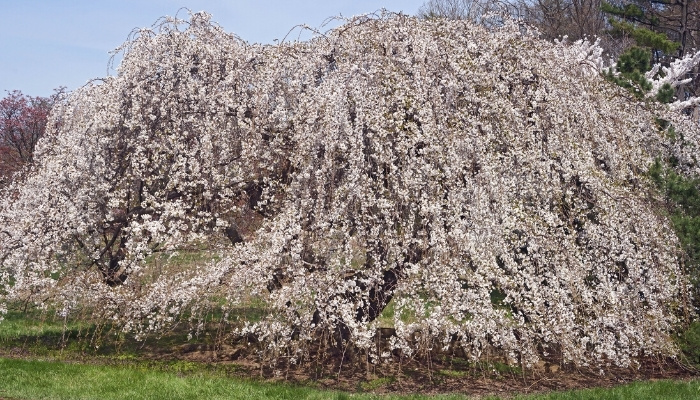The Weeping Yoshino cherry tree is a stunning tree of moderate size that is ideal for a variety of landscape designs.
Its cascading branches, adorned with delicate blossoms, create a poetic silhouette that embodies both grace and grandeur.
This is not just a tree; it’s a seasonal event that heralds the arrival of spring with a breathtaking display of flowers.
The Weeping Yoshino cherry tree offers a unique blend of aesthetic appeal and cultural significance.
Weeping Yoshino cherry trees thrive in full sun to partial shade and prefer well-drained soil with a slightly acidic pH. Regular watering is essential but avoid waterlogging. Annual fertilization can help promote healthy growth, and pruning should be done after the flowering season.
In the following, we’ll provide a comprehensive overview of the Weeping Yoshino cherry tree.
From its botanical characteristics to its growth conditions and maintenance, we’ll cover everything you need to know to cultivate and enjoy this stunning tree in your own garden.
Key Takeaways
- The Weeping Yoshino cherry tree is a stunning tree known for its springtime display of white to light pink blossoms. It has a moderate growth rate and reaches a mature height and width of 15-20 feet.
- This tree thrives in full sun to partial shade and prefers well-drained, slightly acidic soil.
- It requires regular watering, annual fertilization, and pruning after the flowering season.
- The tree can be susceptible to pests like aphids and scale insects, and diseases such as leaf spot and powdery mildew.
If you’re captivated by weeping cherry trees, then my detailed article Gorgeous Weeping Cherry Tree Varieties is an absolute must-read!
Weeping Yoshino Cherry Tree
Before we get into the specifics, let’s take a quick look at the tree’s main characteristics and needs.
| Aspect | Description |
| Botanical Name | Prunus x yedoensis pendula |
| Mature Height | 15-20 feet |
| Mature Width | 15-20 feet |
| Growth Rate | Moderate |
| Light Preferences | Full sun to partial shade |
| Ideal Soil | Well-drained, slightly acidic |
| Watering Needs | Regular, especially during dry periods |
| Fertilization | Annually, using a balanced fertilizer |
| Bloom Times | Early to mid-spring |
| Bloom Color & Fragrance | White to light pink, fragrant |
| Fall Foliage | Yellow to bronze |
General Appearance
The Weeping Yoshino cherry tree is a true showstopper with its cascading branches creating a “waterfall” of blossoms in spring.
Its leaves are glossy green, providing a beautiful contrast to the delicate flowers. The tree’s overall form is rounded with a typical weeping habit that adds a touch of elegance to any landscape.
Seasonal Color
The Weeping Yoshino cherry tree is a celebration of seasons. In spring, it’s a cloud of delicate white to light pink blossoms that fill the air with a sweet, pleasant fragrance.
As the seasons change, so does the tree. The glossy, green leaves of summer transition into a vibrant display of yellow to bronze hues in fall, offering a visual feast that signifies the changing seasons.
Growth Rate & Mature Size
With a moderate growth rate, the Weeping Yoshino cherry tree reaches a mature height and width of 15-20 feet. Its size makes it a versatile choice for landscapes of various sizes.
Despite its moderate growth rate, each year brings a noticeable change, adding a sense of dynamism and growth to your garden.
Blooms
The blooms of the Weeping Yoshino cherry tree are truly a sight to behold. They emerge in early to mid-spring, covering the tree in a blanket of white to light pink.
The blossoms are not just visually stunning but also fragrant, filling the surrounding air with a sweet, pleasant aroma.
The blooming period is a spectacular event that attracts admirers and signals the arrival of spring.
Fall Foliage
As autumn arrives, the Weeping Yoshino cherry tree puts on another show. The glossy, green leaves transition to shades of yellow and bronze, creating a warm, vibrant display.
The fall foliage adds a new dimension to the tree’s beauty and provides a colorful finale to the growing season.
Life Expectancy
With proper care and optimal growing conditions, the Weeping Yoshino cherry tree can live for several decades.
It’s a tree that grows with you, providing beauty and joy for many years. Its longevity, coupled with its stunning seasonal displays, makes it a cherished addition to any garden.

Weeping Yoshino Cherry Tree Growing Conditions
Understanding the growing conditions of the Weeping Yoshino cherry tree is key to its successful cultivation.
This tree has specific requirements for sunlight, soil, and climate that, when met, allow it to thrive and produce its spectacular blooms.
The Weeping Yoshino cherry tree is native to Japan and is well adapted to temperate climates.
It’s a hardy tree that can withstand cold winters, and it needs a period of dormancy to produce its stunning spring blooms. Here are the key growing conditions for this remarkable tree.
Grow Zones and Hardiness
The Weeping Yoshino cherry tree is hardy in USDA Zones 5-8. This means it can tolerate winter temperatures down to -20°F when fully established.
It’s a robust tree that can withstand both cold winters and hot summers.
Sun Requirements
This tree thrives in full sun to partial shade. A location that receives at least six hours of direct sunlight each day is ideal.
Adequate sunlight is crucial for the tree’s growth and for the development of its beautiful, fragrant blossoms.
Soil Preferences
The Weeping Yoshino cherry tree prefers well-drained soil with a slightly acidic pH.
It can tolerate a variety of soil types, including clay, loam, and sandy soils as long as they drain well. Poorly drained or waterlogged soils can lead to root problems such as root rot.
Weeping Yoshino Cherry Tree Maintenance and Care
While the Weeping Yoshino cherry tree is a relatively low-maintenance tree, some care practices can help ensure its health and vigor.
These include regular watering, annual fertilization, and timely pruning.
Proper maintenance not only helps the tree grow strong and healthy but also enhances its beauty.
From watering to pruning, each care practice contributes to the tree’s overall health and its ability to produce those stunning spring blooms year after year.
Watering
Regular watering is essential for the Weeping Yoshino cherry tree, especially during dry spells.
While it can tolerate short periods of drought once established, it prefers consistently moist soil. However, care should be taken to avoid waterlogging the soil, which can lead to root rot.
A good practice is to water deeply but less frequently, encouraging the development of a strong, deep root system.
Fertilization
Annual fertilization can help promote healthy growth. A balanced fertilizer, like this one, applied in early spring before the onset of new growth, can provide the necessary nutrients for the tree.
It’s important to follow the manufacturer’s instructions for application rates and to water the tree thoroughly after fertilizing to prevent root burn.
Pruning
Pruning should be done after the flowering season to maintain the tree’s weeping shape and to remove any dead or diseased branches.
Pruning also helps to improve air circulation within the tree, reducing the likelihood of disease.
When pruning, make sure to make clean cuts and to avoid leaving stubs, which can be entry points for disease.
Pests & Diseases
The Weeping Yoshino cherry tree, like any other plant, can be susceptible to certain pests and diseases.
However, with proper care and monitoring, these can be managed effectively to ensure the tree’s health and longevity.
Aphids
These small, sap-sucking insects can be a common pest for many trees, including the Weeping Yoshino cherry.
They can cause the leaves to curl and may lead to the growth of sooty mold due to the honeydew they excrete.
Regular inspection of the tree, especially during spring and early summer, can help detect an aphid infestation early.
Treatments include horticultural oil or insecticidal soap, which are generally safe for beneficial insects.
Scale Insects
Scale insects are another pest that can infest the Weeping Yoshino cherry tree. They appear as small, bumpy growths on the tree’s branches and leaves.
Like aphids, they feed on the tree’s sap and can cause yellowing of the leaves and an overall decline in the tree’s health. Horticultural oils can be effective in controlling scale insects.
Leaf Spot
This is a fungal disease that causes spots on the leaves of the tree. The spots can be of various colors, including brown, black, or gray, and can lead to premature leaf drop.
Good air circulation, proper watering practices, and regular cleanup of fallen leaves can help prevent this disease. If an infection occurs, fungicides can be used as a treatment.
Powdery Mildew
This is another fungal disease that can affect the Weeping Yoshino cherry tree. It appears as a white, powdery coating on the leaves and can lead to leaf distortion and premature leaf drop.
The disease thrives in humid conditions, so ensuring good air circulation within the tree and avoiding overhead watering can help prevent this disease. Fungicides can be used if an infection occurs.
Verticillium Wilt
This soil-borne fungus can be a serious problem for the Weeping Yoshino cherry tree. It causes wilting and yellowing of the leaves, often on one side of the tree.
Unfortunately, there is no effective chemical control for this disease.
The best strategy is prevention, which includes proper watering, avoiding injury to the tree’s roots, and not planting in soil where the disease has been present.
Landscape Uses & Wildlife Value
The Weeping Yoshino cherry tree is a versatile addition to any landscape. Its stunning beauty and compact size make it an excellent choice for a specimen tree in residential gardens.
It can also be used in parks and public gardens, where its springtime display can be enjoyed by many.
Beyond its aesthetic appeal, the tree also offers significant wildlife value. Its blossoms attract a variety of pollinators, including bees and butterflies, contributing to local biodiversity.
Birds are also attracted to the tree, adding to its value in a wildlife-friendly garden.
Companion Plants
When planning a garden, it’s important to consider how different plants will look together.
For the Weeping Yoshino cherry tree, consider companion plants that complement its beauty and require similar growing conditions.
Spring-flowering bulbs like daffodils and tulips can provide a burst of color at the base of the tree.
Similarly, ground covers like vinca or hostas can provide a lush, green backdrop for the tree.
For contrast, consider planting the tree near evergreen shrubs, which will provide a dark-green backdrop that makes the tree’s spring blossoms stand out even more.
Where To Buy
The Weeping Yoshino cherry tree is available at many nurseries and garden centers. However, for convenience and healthier trees, consider buying from online nurseries.
Here are a few options that I recommend:
Closing Thoughts
The Weeping Yoshino cherry tree is more than just a tree; it’s a celebration of nature’s beauty and the changing seasons.
From its breathtaking spring blossoms to its vibrant fall foliage, this tree offers a visual feast throughout the year.
With the right care and conditions, it can be a stunning addition to your garden, providing joy and beauty for many years to come.
Eager to learn more about the different weeping cherry varieties? You won’t want to miss reading these next:
- Pink Weeping Cherry Tree: How To Grow & Care for This Beauty
- Snow Fountain Cherry: Beautiful Weeping Tree (Full Guide)


